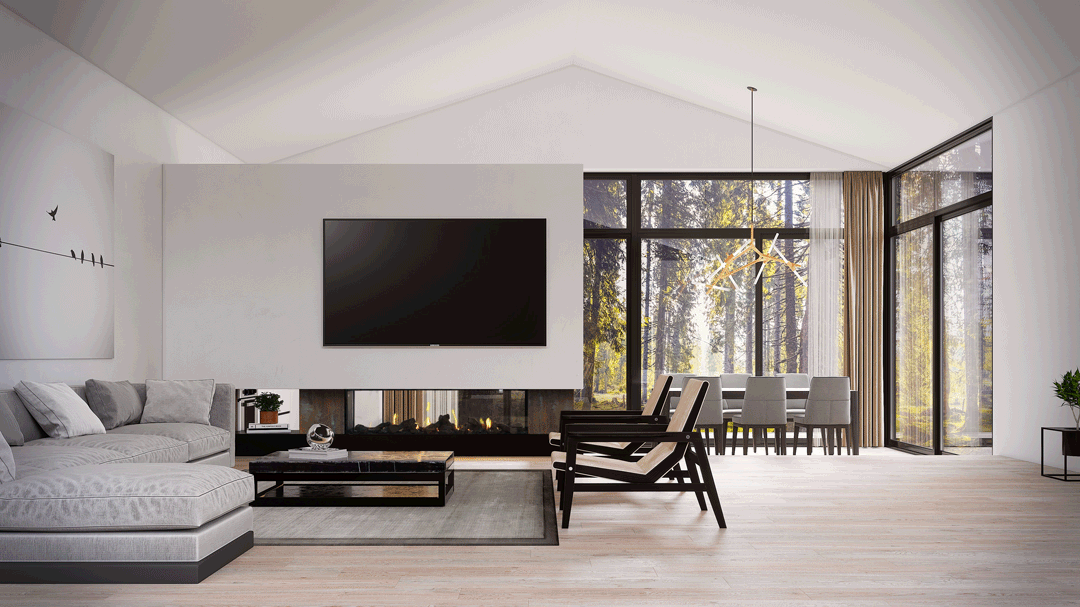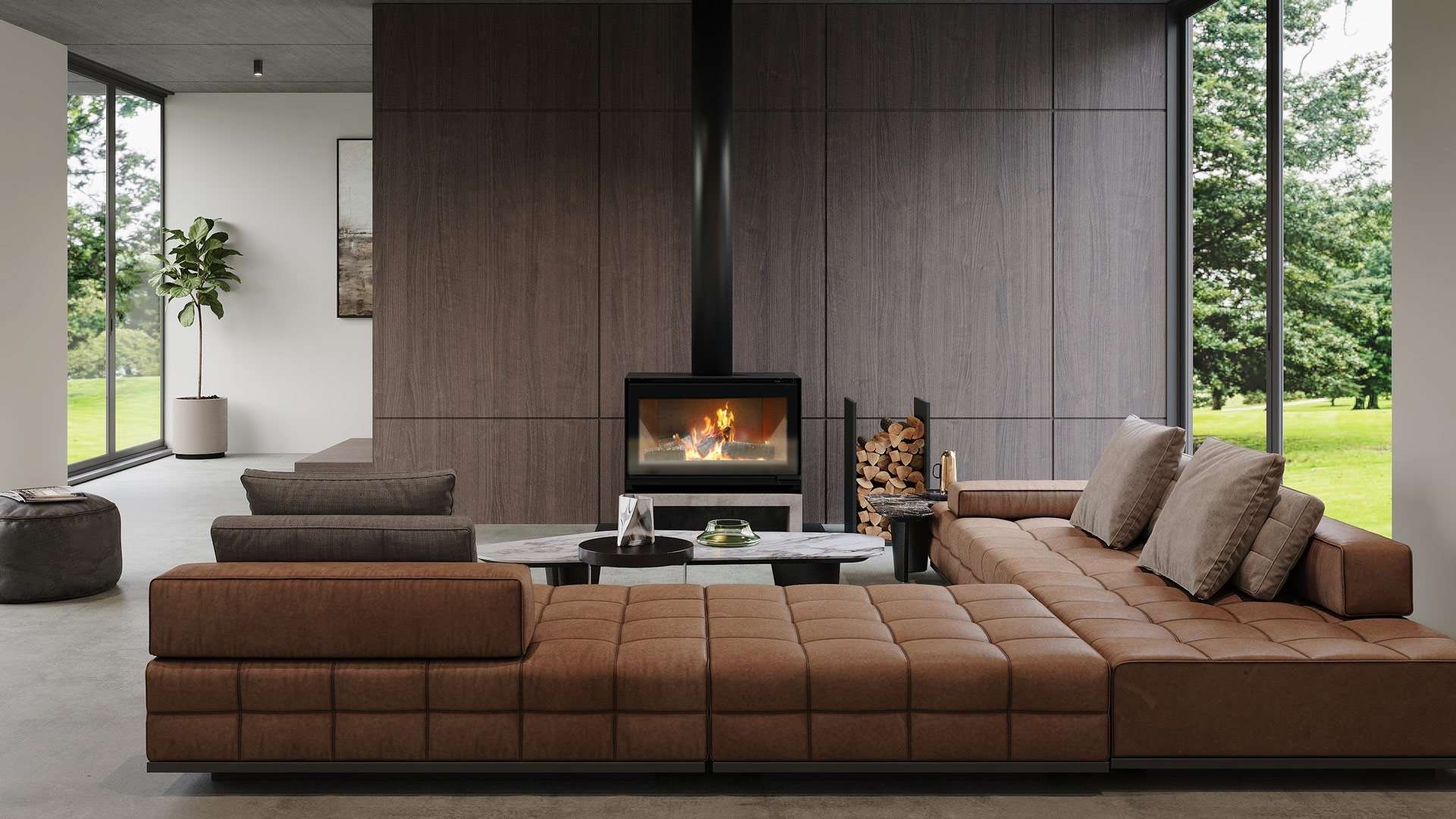So you’re looking to install a new fireplace and you’re tossing up the advantages of gas, wood and electric?
You may have heard that wood has the highest heat output, but gas is highly efficient. Gas has better looking flames than electric, but electric is easier and cheaper to install…
In fact, there is a lot more to consider when comparing the three fuel types before deciding which is the best fit for you – from your interior design aspirations and your day-to-day lifestyle, to the very environment you live in.
The solution will be unique to you, but the considerations are universal – so here’s what you need to think about.
Maintenance

Gas fires require very little effort or maintenance – switch it on when you need it and give it a service once a year! Image: MODE Peninsula
Firstly, how is the fireplace going to fit around your daily life? Are you away during the day or at home? If you are time poor, chopping wood and kindling and tending to the fire every hour or so may not be realistic. Not to mention the chimney cleaning.
Gas and electric are both great solutions here with very little maintenance other than a yearly service - and turning it on is as easy and immediate as the touch of a button.
Flame

Spartherm wood fires are famous for their large windows, perfect for flame-viewing. Image: Ray Tiddy
There’s nothing like basking in front of the flames of a real wood burning fire. While gas and even electric fires have come a long way when it comes to flame picture, you can’t go past the crackling sounds of the wood and the smell of burning ironbark or macrocarpa. And if you’re after the romance of wood then you probably love the whole process and don’t mind the prep and maintenance.
For the ultimate flame viewing experience, you can’t go past a fireplace with big glass windows like the Spartherm XL. For something more modest, the new Spartherm Freestander is a great option.
Design Freedom

Escea’s flexible flues can be run in any direction, allowing you to put your fireplace anywhere in the room.
If you’re looking to challenge convention when it comes to your fireplace design, electric fires are going to give you the most installation freedom. With no need for a flue, installation is quick and easy.
However, if you’re wanting something with a little more impact and more realistic looking flames then you should be considering a gas fire.
Escea gas fireplaces have flexible flue technology, allowing the flue to be run in any direction, meaning you can imagine your fireplace virtually anywhere – even in the middle of the room.
This technology has produced some of the most striking designs in the architectural world, from under bench installations to double sided room dividers.
Learn more about flue’s and what they mean for your fireplace installation here.
There’s more...
Escea Gas Fireplaces also have zero clearance technology that gives you more surround options and ultimately, more creative freedom.
This technology also means a smaller TV clearance for those who can’t decide between a fireplace or TV in their living room. This combination is made even more appealing with Samsung’s The Frame TV which doubles as a world class gallery of art when it’s not playing your favourite DIY show.
Efficiency

All Escea gas fireplaces are room sealed, this is what helps them achieve a 5-star efficiency rating.
There is a popular misconception about gas fire efficiency, while historically, they were open fronted, using the surrounding air to burn and pushing cold air back in to the room – they’ve come a long way since then.
Escea’s gas fireplaces are room sealed and glass fronted, with direct vent technology and hand crafted heat exchangers which heat the air before returning it to the room, rather than seeing it escape up the flue. A far more efficient way of heating than most wood fires.
Electric fireplaces can be a great solution to heating smaller spaces as they put out a more modest amount of heat – and that could be all you need.
However, when we’re talking about heat output, wood is still King.
Technology

Escea’s Smart Heat App allows you to control your fireplace remotely.
If you live a fast-paced life and you often rely on smart technology to get you through the day, you’ll want that convenience to extend to your home heating and in that case, you’re looking at either a gas or electric fire.
Escea’s smart heat app allows you to control your fireplace remotely. You can set timers, adjust the temperature, and control multiple units from the comfort of your sofa – or even from your smartphone when you’re away from home.
Ambe Electric fireplaces also have smartphone control, allowing you to moderate the temperature and even run your fireplace simply as a display with no heat output.
Environment
We all want to do right by mother nature, but when it comes to choosing a sustainable heating source for your home the answer is not black and white.
In fact, wood, gas and electricity can be very comparable when it comes to their long-term environmental impact, and the best option for your home will be unique to your environment.
If you’re burning wood for example, while it is a renewable energy source you also need to consider the type of wood you’re burning and where it’s coming from. Some wood types will have a larger carbon footprint attached depending on where they’ve travelled from. It’s also important to consider that other variants will impact the efficiency and therefore sustainability of burning wood, such as; wood type, size and dryness. Learn more about this here.
If you’re leaning towards gas, you’ll need to consider the efficiency of the heating unit you’ll be using as this will play a large part in the overall environmental impact.
Finally, when it comes to electricity, the sustainability of this option will depend on where you live and how the electricity in your area is generated (for example, via solar panels, wind farms or dams; or by burning coal or oil to generate electricity?).
Cost

Ambe Electric Fireplaces are a cost-effective alternative for those who love the look of a fireplace – on a smaller budget.
When it comes to cost, you also need to factor in efficiency. While electric fireplaces may appear to be the cheaper option, this will depend on how often and for how long they need to be in use compared with wood or gas fires, and whether they’re your main source of heating.
Wood fires are often considered to be cheaper than gas, however there are additional things to consider when it comes to cost efficiency and again, this will be unique to you and your environment.
You’ll need to factor in the cost (if any) of sourcing firewood and whether the gas fire is running on bottled or natural gas. Then, consider how you plan to use your fireplace, how frequently and for how long the fireplace is likely to be in use; it can take a while to get your woodfire up to peak heat output, but once it gets there it will heat the house well – great for a long night in.
The Conclusion
There’s a lot to consider, and plenty of pros and cons for each. At the end of the day, it all comes down to you, your lifestyle and your home. The key advice from Stoke is to work out your priorities when it comes to the design and daily function of your fireplace, then speak to a professional about what will work best in your space.
5 Key Questions to ask yourself before specifying a fireplace.
- Will it be your main source of heating?
- What about your lifestyle – do you have time to prepare and maintain a woodfire or do you need something easier?
- What are your design aspirations and what level of flexibility do you need in order to achieve them?
- What’s going to be the most sustainable option, based on your unique home and surroundings?
- Finally, what is your budget – both for the fireplace and the installation.








